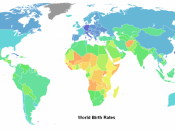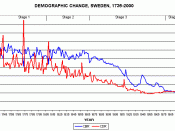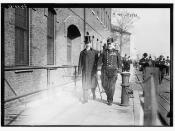As the mortal haze of World War II had finally settled, a light of hope brightened the western world. It was a time of new growth, economically, politically and demographically. With the average rate of increase at 1.6% the population soared to a new level (Meyer, 26). The western world entered a new era commonly known as the baby boom. As a precise example of the demographic transition model (DTM), the baby boom indicated a population explosion (Meyer, 27). In many developed countries the transition began in the eighteenth century and continues through the final stages today. Less developed countries began demographic transitions much later, and thus are still in the primary stages of the model. Today demographers rely on statistics to indicate the movement of populations, as well as to determine how accurately the DTM is operating. Throughout history inaccurate forecasts have created doubts with regards to the accuracy of the model.
The DTM must be taken in humility; it is an estimation of future trends, not a precise account (Simon, 327). With consideration to world population data, and the progression of population increase in many under developed countries sufficient evidence indicates that the demographic transition model is an adequate predictor of population growth.
The demographic transition is a process of change in a countries population. The DTM generalizes the population transition from high to low fertility and mortality rates. The model serves as an approximation of what occurred to fertility and mortality rates in Western Europe, also in a sense the demographic experience of developed nations (Bongaarts, 18).
Over a period of time as countries develop and become industrialized a shift occurs as fertility and mortality rates decline. As a result of the downward inclination there is a noticeable shift from rapid population growth, to slow growth, to...


